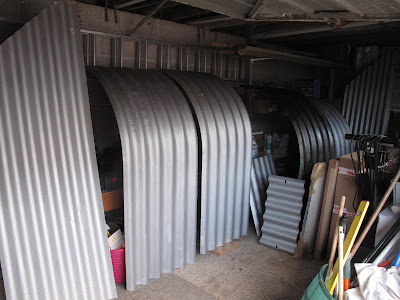The first job was to mark all the areas of imperfection from the previous day's filling; I used chalk to circle these, that way I would be able to fill in the areas appropriately.
After a lot of sanding, refilling, sanding etc. etc. I got a finish I was happy with on the inside of the panel; once the shelter is in place in the ground, this will be the only surface visible!
Next, the panel was painted with rust-protecting silver paint. When I looked at my watch, I realised that this 'little' job had taken six and a half hours!
 The panel was left to dry, while I tidied the potting shed. Hooks were put in place to hand the garden tools from, and room was made in preparation for the completed shelter panels to be stored.
The panel was left to dry, while I tidied the potting shed. Hooks were put in place to hand the garden tools from, and room was made in preparation for the completed shelter panels to be stored.Once the paint was completely dry, it was time to lay out the panels and admire our workmanship! The following photos show the completed panels, minus the 3 rectangular end panels. These will be cut from the corrugated sheet being donated by Plymouth City Museum, which should be a relatively easy job, as will painting them.
The completed Anderson 'kit' with one of the original 'scrap' pieces; many of the panels were damaged like this!
What it looked like before work began!
The Anderson in its temporary home in the potting shed; it will soon be in the ground!
At this stage of the project, as we near completion, I would like to thank all those people who have helped out and given their time freely to assist with the renovation of the Anderson shelter. It will not only enhance our 1940s garden greatly, but I hope it will also give the children a real understanding of what ordinary people went through during the dark days of the blitz, and how their own lives would've been affected had they been alive during the war.
Thank you to Roland at Plymouth City Museum for helping with the initial location and collection of shelter, and for providing additional materials to help complete it.
Thanks also to Debbie & Tom for your help with the painting; it is very much appreciated! It has been lovely to hear all the comments from colleagues and parents who have been keeping up to date with the progress made during the project, and showing great interest when passing by on their way to collect their children from school. Thank you to Lucy for regularly providing us with coffee; this was a vital part of the success of the project!
Lastly, I would like to thank Kay for her dedication and support throughout not only this, but all of the projects within the school garden over the last 3 years. She has always given her time freely, faced every challenge with enthusiasm and good humour, and managed to keep all of her limbs, despite some rather 'extreme' angle-grinding!! Her help is appreciated enormously.
































































